After a relaxing day in Lampang, we immersed ourselves in the world of elephants. A century ago there were an estimated 100,000 domesticated elephants in Thailand, with several times that in the wild. Today only about 4000 remain, with more than half in captivity. We spent five days at the Thai Elephant Conservation Center (TECC), dedicated to increasing conservation and knowledge about elephants.
- Reclining Buddha at Wat Ponc Sanuk Nua, Lampang
- Four Buddhas under a tree-of-life
- Wat Ponc Sanuk Nua
- Another cool roofline,
- and a temple guardian, at Watkoh Walukaram
- Richard and Jami, at our elephant lunch
- Yellow legs after balm massage
- Arriving at Thai Elephant Conservation Center
- Jami greeting Prajuab and Noot (elephant and mahout)
- Happy to see a friend
- I recognized Wanalee from the rear by her crooked tail.
- Into the forest
- Fun in the water
- Tiam, Wanalee’s mahout
- A spirit house
- Suzette had no idea what was about to hit her.
- Pangkod
- Making medicine logs for older elephants
- At the show, demonstrating logging
- and painting (guided by mahout)
- Sharmon on PangKod, a tall elephant
- That’s me, walking with Wanalee
- A dusty elephant
- Having fun
- I didn’t realize that some elephants have colorful spots.
- Wanalee had the longest eyelashes.
- A dusty trail
- Deborah and Tiam
- One-year-old Baiboon was very playful.
- Judith-Kate and Dao, her elephant’s mahout
- One of our lunch spots
- Pointing out the Jacobson’s organ in the roof of elephant’s mouth which enables them to recognize the identity and gender of other elephants.
- Enjoying a good scratch after a roll in mud
- A fun group
- Val helping with dinner prep
- A party in the street
- Children everywhere today
- Watch out for elephants
- Getting a drink on the way to campsite (river was dry)
- Pangkod decided to take a full shower
- Our camping platform
- Val in our mosquito netting cube
- Lunch at camp
- Val and Suzette cutting firewood
- Tiam carving me a bamboo mug
- Sticky rice cooking inside bamboo
- Dinner at camp
- Heading back to the village
- Bathing the elephants
- Greeting friends
- Jon and Suzette had way too much fun together.
- Amnat
- Phet
- Kie
- Jami, Moi, and Fern
14 December – Lampang
We had free time in the morning, so I took a walk with Sharmon and Suzette. We found a shimmering temple, crossed a bridge, walked along the Wang River, and went to see Wat Ponc Sanuk Nua. On our way back we came across what was once a beautiful teak building, now decaying. We reconnected with Judith-Kate and Valerie who had been having massages, and got a van ride to lunch to meet Richard Lair, a renowned elephant expert. He regaled us with stories about his 40+ years in the elephant world, starting at Marine World when it was in Redwood City. Since, sadly, there are more domesticated than wild elephants in the world, he made them his specialty and has worked hard to train mahouts and others in the proper care of this amazing animal. Perhaps due to their long lives, about sixty years, elephants have not been selectively bred as have other domesticated animals, so they retain their wild nature.
After lunch those of us who had not had massages in the morning got dropped off at the Herbal Center for one-and-a-half-hour balm massages. The first half was like a traditional Thai massage; in the second half we got padded with hot balls of herbs. My legs remained yellow for several days thanks to the tamarind they contained.
Jami and I got dropped off at an ATM on our way back to our hotel, for one last withdrawal from my checking account. On the elephant tour part of my trip, most of my cash has been spent on souvenirs since meals are included. I immediately made a purchase on my way through the street market, spending about $3 for a cute cotton jacket. We ate dinner on the patio cooked by our host’s staff: delicious chicken, fish, jackfruit salad, vegetables, and a couple small meat dishes.
15 December – meeting our elephants
It took about an hour to get to the primary destination for this tour, the Thai Elephant Conservation Center (TECC). The center has about 120 elephants and more mahouts; each of these men paired with an elephant. We sang a few songs on the way. When we reached the center, we unpacked at Home Stay, my bamboo hut is dark and musty, and changed into mahout suits: large, baggy, denim outfits.
We were then introduced to “our” elephant, all female. Mine is named Wanalee, she is 22 years old, and one of the shorter elephants. Her mahout, Tiam, is one of the older ones. The elephants were happy to get a break in their routine. Four of them, including Wanalee, are usually in the elephant show, and the fifth is a “taxi elephant” giving rides to tourists. They eagerly greeted their friends as we headed to the forest, one of them trumpeting goodbye to an elephant temporarily confined due to a leg injury.
We hiked about six miles with Wanalee bringing up the rear, eating the whole time. One of her favorites was bamboo. She pulled down the stalks, stepped on them and stripped off the leaves. She weights 3000 kg (6600 lb); this is more than three tons, about the weight of two cars. For her size, she has been deemed to be a bit overweight, so she and a few other elephants now have a daily walking routine so they can lose a couple hundred kilos.
The elephants were staked out in various spots in the forest while we had our lunch break. For our walk, most wore a chain around their right front foot which was draped across their neck much of the day. We were served sticky rice and chicken, tofu for the two vegetarians, wrapped in a banana leaf. I saved the leaf and much of my rice for Wanalee. The elephants were dusty when the mahouts gathered them, so they had them lay on their sides and we helped sweep them off with leaves. On our way back to the village, the mahouts climbed onto their elephants and walked them into the water to bathe them. They liked that.
We got back down in the mid-afternoon and the elephants were returned to their overnight spots. We picked up cold beverages and snacks at the tiny village market and changed out of our mahout outfits. I must be jinxed when it comes to showers because for the third place in a row, I had no hot water, so my hair is still dirty. Someone reset the heater afterwards, so hopefully I’ll get a warm shower tomorrow. Dinner was delicious: green curry, vegetables, and rice, with sweet potato balls for dessert.
16 December – learning about TECC
Jami lent me a Thermarest pad to add to the hard mattress so I slept fairly well. A few roosters started crowing around 4:00 a.m. but they stopped soon and I got back to sleep, until the whole chorus began at 5:30.
We walked up to collect elephants at 7:00 and watched the mahout routine. Tiam gave Wanalee a pile of hay to eat while he raked the area around her. Lots of food in means lots of dung out. He unchained her and had her lie on her side so he could sweep her off; I helped by swatting her with a rag. We walked down to the body of water, nicknamed Poop Pond, where the elephants got bathed. I rode with Tiam and we walked Wanalee into the water. I got soaked to my waist, while he rolled up his pants and stood on her back and stayed dry. I continued my ride to showgrounds, where she and others were stacked and fed, ready for the three short performances they do each day.
I took a hot shower before breakfast and changed into a new mahout outfit. We had rice soup with bowls of chicken, egg, cilantro, and garlic to add. A truck picked us up to give us a ride to the mahout training center, a few of us rode in the cab instead of the back. The muscle I pulled in Chiang Mai bothers me most when I sit on hard surfaces. Our first stop was the camp where they keep the dangerous elephants (16 males and two females), those who have broken their chains and frightened or harmed people. They are handled by experience mahouts, with a team of two each time they are moved. Male elephants in musth must also be handled carefully. During these hormonal periods even the most placid elephants can become aggressive.
At the mahout training center, Pune (“Bun”), a retired mahout, oversaw our production of medicine logs for elder elephant: rice, roots, bananas, and lot of herbs crushed together with a foot-pumped pestle. We also stopped by the hospital. TECC provides free medical care for any elephants brought to the center. Two elephants were recovering from surgery. Both had been overfed unhealthful foods and their babies died in the womb, too big to be delivered. Giant slings were available to hold the elephants upright while anesthetized.
After lunch, we watched the elephants bathe again, this time with paying tourists riding in and getting soaked, then saw the elephant show. The show is more educational than entertaining. It demonstrated how elephants were used for logging, and some of the things they can do with their trunks which contain thousands of muscles. Afterwards we walked or road with them back to their night spots. The rest of the afternoon was spent resting, drinking beer (some of us), chatting, and enjoying another tasty dinner.
17 December – another forest walk, baby elephants, and a museum
This morning we collected our elephants at 6:30, ate breakfast, and headed out into the forest. I road on Wanalee for the first fifteen minutes just to have the experience of seeing the world from that vantage point; it was more comfortable than I expected. On our way to our lunch spot, a bamboo platform in the middle of forest, we stopped to visit two baby elephants, each in a large pen with their mothers. Moonbeam is two years old and Baiboon is one. We played with Baiboon for quite a while. She is so cute! (There is a chance that Wanalee is pregnant, since she had a “honeymoon” with a male a few months ago. Her first calf died after birth about five years ago.)
After a leisurely lunch break we got picked up in a truck and went to see the TECC museum. It has exhibits about the different types of elephants and their history. Mammoths, African and Asian elephants have a common ancestor. Asian elephants are the smallest ones, though I wouldn’t consider them small by any other definition. The ones we are meeting are of the Indian subspecies. Based on a small carving found in Pakistan, elephants have been domesticated for at least 5000 years. They have been part of the Thai culture for centuries and used for many purposes, including war, transportation, and logging.
We went to a few markets and while the cooks purchased dinner ingredients, we shopped a bit. Judith-Kate bought one of the brooms we’ve all been admiring. Back at TECC we helped with a bit of chopping for dinner: yellow chicken curry and delicious veggie soup. We then had a party. The mahouts rolled out a couple bamboo mats in the middle of the street and the Mahout Band played for us. Val joining in with the drumming. There was singing and dancing in the street, with shots of white whiskey (the worst I’ve tasted yet) passed around. We all laughed watching the mahouts perform the elephant dance. Great fun, all rolled up and quiet by 21:00.
18 December – camping
The camping portion of our visit was almost canceled due to drought and we would have missed a wonderful day. Instead it was shortened from two nights to one and large barrels of water were trucked in for the elephants. The elephants wore long lengths of chain around their necks so they could move about while staked out in the forest overnight. We reached our camping spot before noon. Our gear was delivered by truck so we didn’t need to carry much. I walked almost seven miles today, possibility the furthest since I started my trip.
When we arrived, we honored the spirits of the land, lighting incense and putting food in the spirit house. Lunch was served at a picnic table with large banana leaves as a tablecloth; I later fed some to Wanalee. We set up our bedding on a bamboo platform inside mosquito nets, two women per cube. I shared one with Val.
After a welcome siesta, the fun began. We helped cut wood for the fires and bamboo for everything. We admired the mahouts carving ability as they made bamboo cups and stirring spoons for us. Dinner was served in bamboo troughs on a large tarp, and with translation from our guides, Fern and Amnat, we learned move about the mahouts’ lives. Most had never finished school and came to this work due to lack of other options and a love of elephants. They would like to see more trips to the forest and less time in the elephant shows. They toasted Jami for all the joy she has brought over the years. This is going to be her last year leading tours in Thailand; she will be missed. The dishes were shoved to the middle and singing and dancing began. We observed and half-way learned some crazy dances, including a chicken dance and one about fruit, each one speeding up as it progressed. They got a kick out of the hokey-pokey and when Shar mentioned that we don’t go faster and faster, that’s just what we did, laugher all around. The fun switched to card games after we farangs (white people) retired around 9:00.
19 December – goodbye to the elephants and all the wonderful people at TECC
I had a rough night, even with a Thermareast on top of a thin pad, my hip hurt. Fortunately, I was spared the biting ants that got into Shar’s bag. Pune, who never stops working, had a fire going by the time I got up at 5:00, and boiled water for us in large bamboo columns. It was scooped out with bamboo dippers. We ate breakfast, rice soup again, just after sunrise, packed up and headed back. Tiam took a video of me walking through the bamboo with Wanalee following behind. I am definitely much more comfortable around her, and the other elephants, than I was when I first met them. We posed for a group pictures and bid a sad goodbye our elephants and mahouts. I left my sandals with Tiam.
It felt great to remove my mahout clothes and take a hot shower. We had a final meal, kao sai, with our guides and I got an iced Thai tea for the road, yum. We said our final goodbyes, climbed into the van, and headed off to our last stop, Chiang Dao.





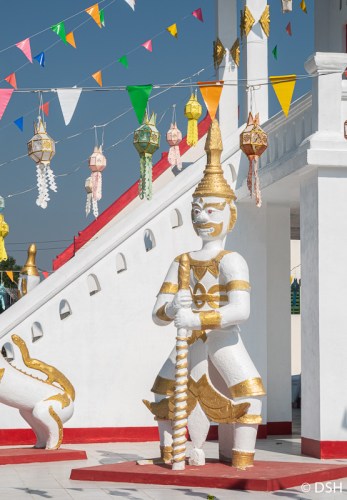




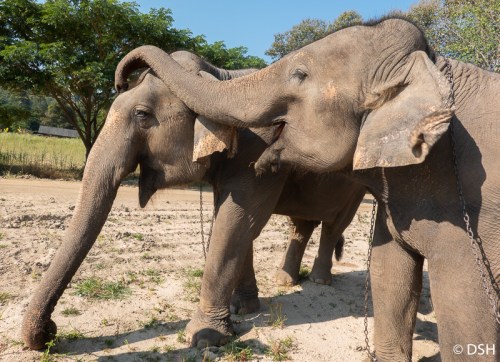





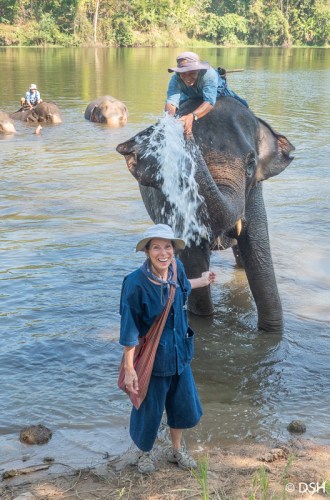





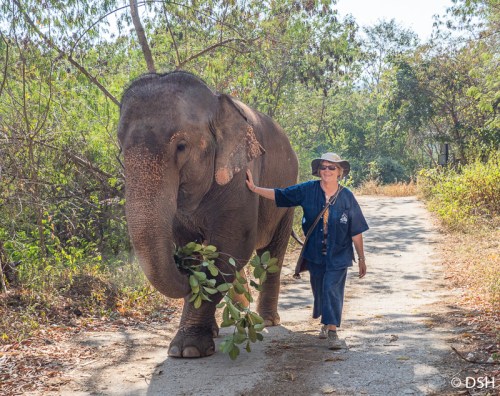

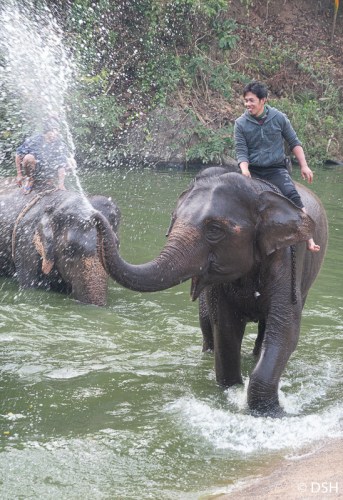
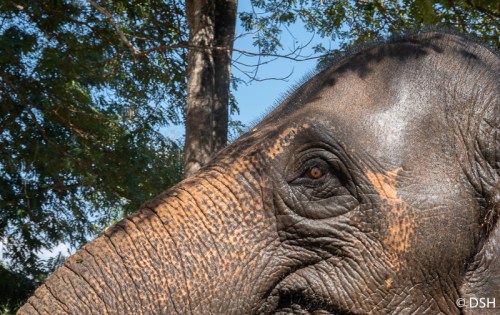


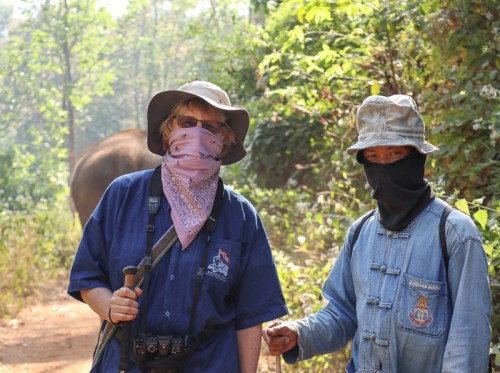

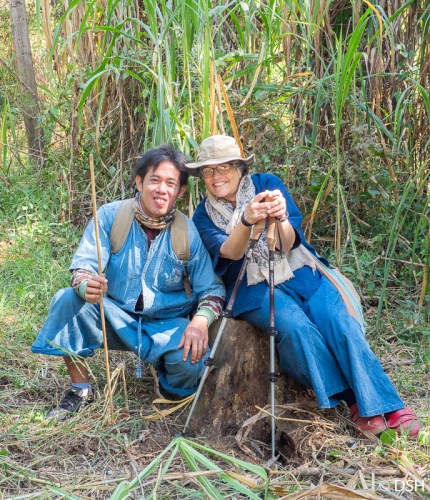
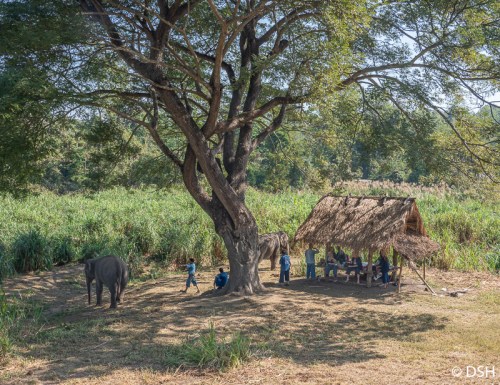
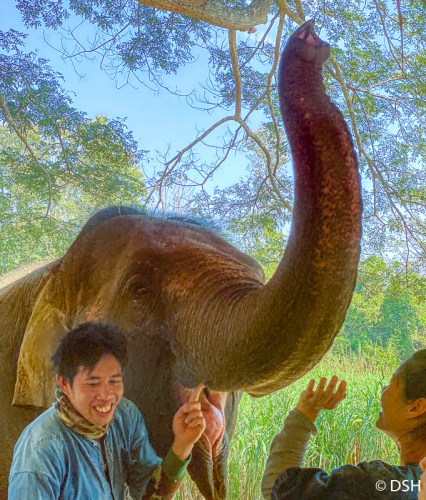






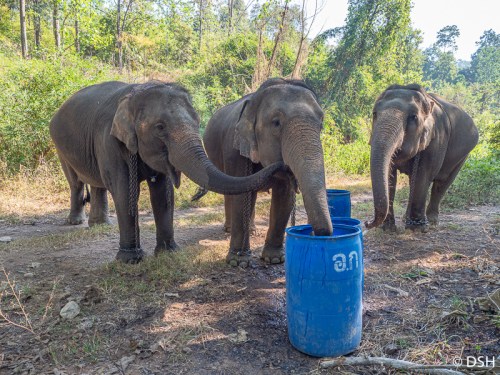

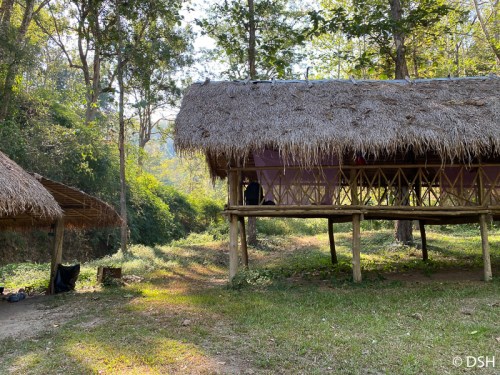
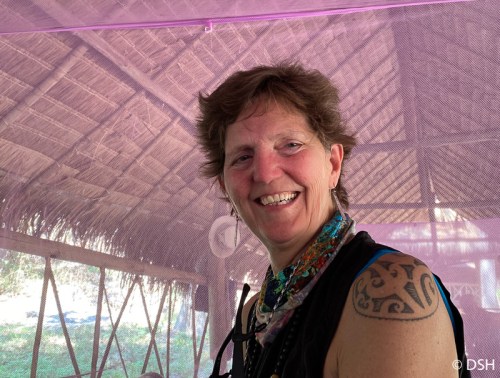



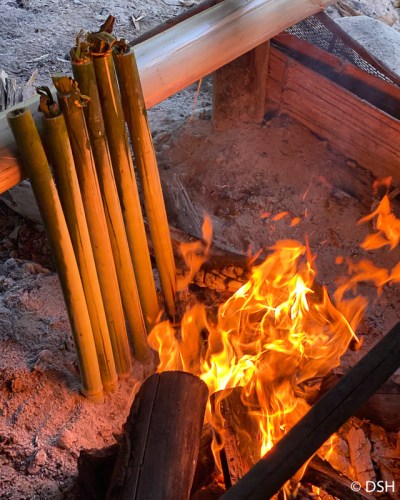
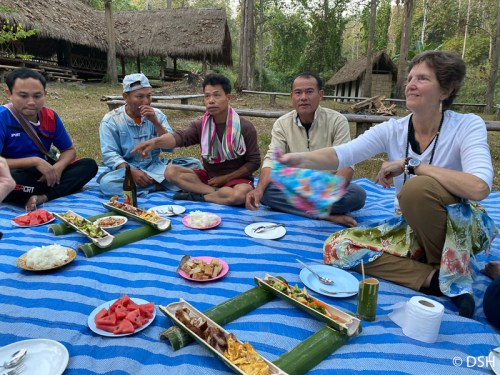
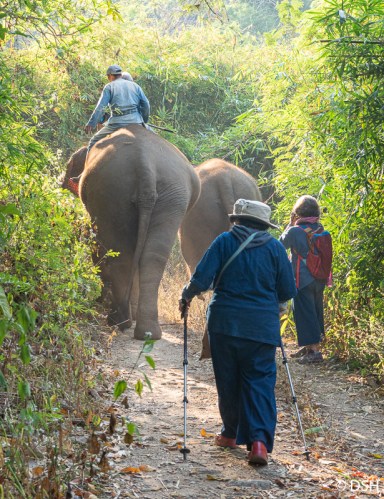


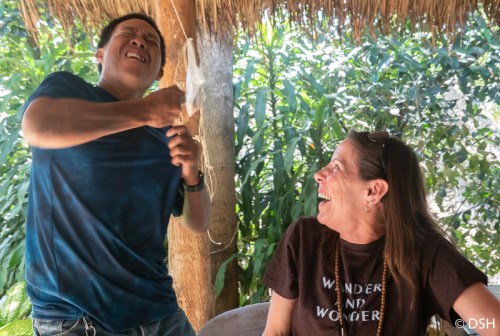




Wow, thank you for sharing these amazing pictures, these amazing people, and you’re amazing adventure. I love the pictures of the elephants. They seem happy And healthy. Are these elephants that people have “Adopted” and support financially?
Thanks for the work that you have put in to your blog. It has been a delight to follow you. Love, Lynne Sent from Yahoo Mail on Android
Thanks for the supportive feedback. It was an amazing experience! Love to you too.
I’m not sure how TECC gets funding, other than from tourism, but if anyone wants to help, I suggest donations to the Mahout Village Project; they are tax deductible if you go through Impact A Village
https://www.impactavillage.org/project-mahout-village-project/
HI Deborah – TECC is a government organization under FIO – Forest Industry Org. They do not have to rely on tourism dollars although it is the tourism dollars that helps to give the mahouts a better salary and helps the TECC elephant hospital (which provides free care to all elephants no matter where they are coming from) The Mahout Village Project was started to support getting the children of the mahout village to the schools that are about 25 minutes away. One cannot look at the elephant crisis in Asia without looking at the mahout crisis – they go hand in hand. If there are no good mahouts taking care of the elephants, then the crisis only gets worse. MVP’s purpose is show support to their important role in caring for the elephant. Thank you for sharing the link. https://www.impactavillage.org/project-mahout-village-project/
Jello Deborah You certainly get around Great photos.Merry ChristmasVirginiaSent from my Samsung Galaxy smartphone.